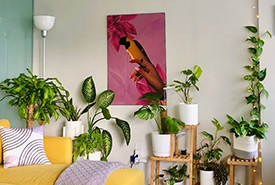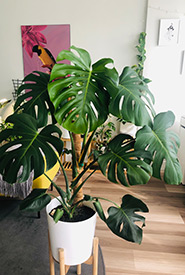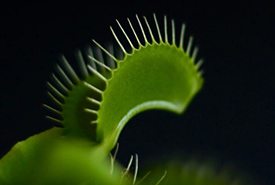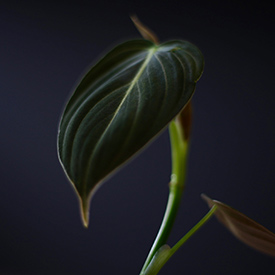NCC: Land Lines – Indoor plants bring me much joy, and they can for you too!

Nila Sivatheesan’s home accented by many indoor plants (Photo by Nila Sivatheesan/NCC staff)
Since the beginning of the pandemic, you’ve likely heard about and experienced the numerous physical and mental health benefits of spending time in nature. But not all of us have the luxury of being out in nature as much as we want to. Some of us (like me) live in small apartments in the city with no yard or balcony.
Some of us (also like me, being both a person of colour and female) don’t always feel safe being out in certain natural areas. Some of us may not have the time or ability to get out and about. And some of us may not have an accessible nature spot nearby to explore.
But does nature have to be outdoors for us to reap its benefits?

Monstera plant (Photo by Nila Sivatheesan/NCC staff)
When I first moved from Ontario to my tiny 500 square-foot apartment in Vancouver, I bought a houseplant: a monstera deliciosa. At the time, it was simply a piece of décor to make our space look and feel nicer. What I didn’t realize was how much it would affect my mental health and make the adjustment of moving to a new city so much easier. Caring for my plant those first few weeks brought me so much joy and provided so much stress relief. A month later, I ended up buying a few more plants: a golden pothos and a couple succulents. And again, I felt my overall mental health improve.
Sixty and counting
Today, almost a year later, I have over 60 plants in my tiny apartment. My anxiety is the lowest it’s ever been in my life. My plant chores (watering, pruning, repotting, cleaning leaves, misting, etc.) keep me busy and provide me with a rewarding hobby. Seeing new growth brings me so much excitement. I’ve joined local plant groups and connected with other plant lovers. And I love that I live in what feels like a tiny jungle!

Arrowhead plant (Photo by Nila Sivatheesan/NCC staff)
Now you’re probably thinking, 60 plants must be expensive and time consuming! But it doesn’t have to be! Many plants can be grown from cuttings and seedlings that you can obtain from friends. You can also find great deals in your local plant groups on Facebook or trade for plants through trading apps like Bunz.
Houseplants can be an affordable and easy way of getting a nature fix. In fact, research has shown that one of the biggest benefits of houseplants could be improving your mental and physical health! And the best part is, you don’t need a green thumb to enjoy the benefits of having houseplants. Growing plants is all about learning through trail and error. Some of your plants will not make it, and that’s okay!
So, have I convinced you to buy your first houseplant?
Here are some tips to get started:
1. Choose plants that fit your lifestyle and your home environment
Every plant has different requirements. And the best way to ensure your plant thrives is to start with choosing the right one for your space.
What type of light does your home get?
Some plants require bright, direct sunlight, while others prefer to be in more shaded areas.
How much time do you want to devote to caring for your plants?

Venus fly trap (Photo by Nila Sivatheesan/NCC staff)
Some plants, like succulents, can go for weeks without water, while others, like the venus fly trap, require consistent moisture and humidity. If you don’t want to devote a lot of time to caring for your plant, choose low-maintenance options like succulents, snake plants or pothos.
Do you have pets or children?
Some plants are toxic to pets and/or humans. So, if you have small children or pets that may be curious and take a bite out of your plant, you’ll want to avoid plants that could be harmful for them. Here are a few examples of pet and child friendly plants.
2. Choose the right pot
One of the most common causes of plant death is over watering. And the best way to avoid this is to ensure your pot has drainage holes. These holes are located at the bottom of the pot and help excess water drain out of your soil.
Have a snazzy pot that matches your décor, but that doesn’t have drainage holes? Place the plant in a slightly smaller pot that does have drainage, and then insert that pot into your decorative pot!
3. Don’t overwater your plants
Sometimes, we tend to give our plants a bit too much TLC, leading to an overwatered plant that ends up dying. An easy trick to check if your plant needs water is to simply stick your finger in the soil and see how wet/dry it is! For most of my plants, I wait until the top 2.5 to 5 centimetres of soil is dry before adding any more water. But this may differ depending on the water needs of your plant.
4. Keep an eye out for pests
Fungus gnats, spider mites, aphids, thrips, mealybugs, etc., are all pests that can harm your plants if left unchecked. Be sure to regularly check your plants for signs of pests, including the stems, soils and undersides of leaves.
5. Enjoy the process

Black-gold philodendron (Photo by Nila Sivatheesan/NCC staff)
Find cute pots or make your own. Display your plants using stands or shelves and decorate your home. Take photos and gush over every new leaf and flower! Join local plant groups to share your moments with and get help and learn from. Give away plant cuttings to friends and family. And remember, it’s okay if a plant doesn’t make it. Just try again.
Welcome to growing your own indoor plant haven.





